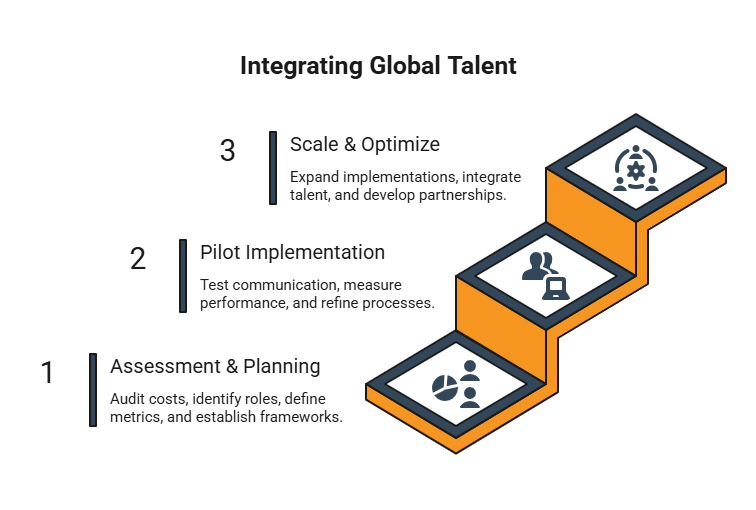- Introduction
- The Confusion That's Costing You Money
- Understanding Your Three Pathways to Global Talent
- Why Australian SMEs Can't Afford to Wait
- The Strategic Framework: Choosing Your Approach
- Building Your Global Talent Strategy: A Practical Roadmap
- Success Stories: Australian SMEs Getting It Right
- How Webco Talent Eliminates the Complexity
- Your Next Steps
- FAQs
Australian SMBs and SMEs are facing an unprecedented challenge.
With skill shortages reaching critical levels across industries, rising operational costs, and fierce competition for local talent, many business owners find themselves caught between growth ambitions and budget constraints.
The numbers paint a stark picture:
Australian businesses are struggling to find qualified staff whilst managing escalating wage costs that can consume up to 70% of their operating budgets.
For small to medium enterprises, this creates a perfect storm where growth opportunities are missed, existing teams are overworked, and competitive advantage erodes.
But here’s what many Australian business owners don’t realise: there’s a world of talent solutions beyond your local market, and understanding the differences between outsourcing, offshoring, and nearshoring could be the key to unlocking sustainable growth whilst managing costs effectively.
The Confusion That's Costing You Money
Walk into any Australian SME and mention “outsourcing,” and you’ll likely hear one of three responses:
- “That’s too complicated for a business our size”
- “Isn’t that just sending jobs overseas?”
- “We tried that once and it was a disaster”
This confusion stems from a fundamental misunderstanding of the three distinct global talent strategies available: outsourcing, offshoring, and nearshoring. Each serves different business needs, offers unique advantages, and suits different organisational requirements.
The cost of this confusion?
Australian SMEs are either avoiding global talent solutions entirely (missing significant cost savings and skill access) or choosing the wrong approach for their specific needs (leading to failed implementations and wasted resources).
Understanding Your Three Pathways to Global Talent
Outsourcing: Your Project-Based Solution
What it is: Outsourcing involves hiring external companies or specialists to handle specific tasks, projects, or business functions. This can happen locally within Australia or internationally.
Best for:
- One-off projects with defined scopes
- Specialised tasks requiring expert knowledge
- Businesses wanting to test global talent strategies
- Companies needing temporary capacity boosts
Australian SME Example: A Melbourne marketing agency outsourcing graphic design work to a specialist firm to handle overflow during busy periods.
Offshoring: Your Cost-Optimisation Strategy
What it is: Offshoring specifically means relocating business processes or hiring talent from distant countries, typically where operational costs are significantly lower.
Best for:
- Businesses prioritising maximum cost savings
- Companies with well-documented processes
- Operations that don’t require real-time collaboration
- Organisations ready to invest in robust communication systems
Australian SME Example: A Sydney accounting firm hiring bookkeeping professionals from Sri Lanka to handle data entry and basic accounting tasks at 60-70% cost savings.
Nearshoring: Your Balance Strategy
What it is: Nearshoring involves partnering with talent or companies in nearby countries or similar time zones, offering a middle ground between cost savings and operational convenience.
Best for:
- Businesses needing regular collaboration
- Companies wanting cultural alignment
- Teams requiring overlapping work hours
- Organisations prioritising communication ease
Australian SME Example: A Brisbane software company hiring developers from New Zealand or Singapore for ongoing development work with minimal time zone disruption.
Why Australian SMEs Can't Afford to Wait
The urgency for Australian small to medium businesses to develop a global talent strategy has never been greater. Here’s why action is needed now:
The Talent Shortage is Accelerating
Australia’s skills shortage isn’t improving. In fact, it’s intensifying across multiple sectors. Traditional recruitment methods are failing, and waiting for the local talent pool to expand isn’t a viable strategy. Businesses that delay global talent adoption risk being left behind by more agile competitors.
Cost Pressures are Mounting
With inflation affecting wage expectations and operational costs rising across the board, Australian SMEs need immediate cost relief. Global talent strategies can reduce operational costs by 40-70% whilst maintaining or improving service quality.
Technology Has Removed the Barriers
Modern collaboration tools, project management platforms, and communication technologies have eliminated traditional challenges associated with global talent. Time zones, language barriers, and coordination issues are now manageable with the right approach and tools.
Your Competitors Are Already Moving
Progressive Australian SMEs are already leveraging global talent strategies to gain competitive advantages. Those who delay risk falling behind in pricing, service delivery, and market responsiveness.
The Strategic Framework: Choosing Your Approach
Start With These Critical Questions:
1. What’s your primary driver?
- Maximum cost savings = Consider offshoring
- Balanced approach = Explore nearshoring
- Specific expertise = Look at outsourcing
2. How critical is real-time collaboration?
- Essential = Nearshoring or selected offshoring locations
- Important but manageable = Flexible offshoring
- Not critical = Full offshoring options
3. What’s your risk tolerance?
- Low risk = Start with outsourcing specific projects
- Medium risk = Implement nearshoring or partial offshoring
- High risk tolerance = Full offshoring strategy
4. How documented are your processes?
- Well-documented = Ready for offshoring
- Partially documented = Start with nearshoring or offshoring
- Poorly documented = Begin with outsourcing
Building Your Global Talent Strategy: A Practical Roadmap

Phase 1: Assessment and Planning (Weeks 1-2)
- Audit current staffing costs and productivity gaps
- Identify suitable roles for global talent integration
- Define success metrics and budget parameters
- Establish communication and management frameworks
Phase 2: Pilot Implementation (Weeks 3-8)
- Start with non-critical functions or specific projects
- Test communication channels and workflow integration
- Measure performance against established metrics
- Refine processes based on initial learnings
Phase 3: Scale and Optimise (Months 3-6)
- Expand successful implementations
- Integrate global talent into core business processes
- Develop long-term talent partnerships
- Establish governance and quality assurance protocols
Success Stories: Australian SMEs Getting It Right
Progressive Australian small to medium businesses are already reaping the benefits of strategic global talent implementation:
- Cost Reductions: Achieving 50-70% savings on operational costs
- Skill Access: Accessing specialised expertise unavailable locally
- Scalability: Rapidly scaling teams without infrastructure investment
- Productivity: Leveraging time zone differences for round-the-clock operations
- Focus: Allowing local teams to concentrate on high-value activities
How Webco Talent Eliminates the Complexity
Developing a global talent strategy shouldn’t require you to become an international business expert overnight. Webco Talent specialises in helping Australian SMBs and SMEs navigate the outsourcing, offshoring, and nearshoring landscape with confidence.
Our approach eliminates common pitfalls:
- No trial-and-error costs: We match you with pre-vetted talent that fits your specific needs
- Simplified management: Single point of contact for all your global talent requirements
- Risk mitigation: Established processes and proven track records reduce implementation risks
- Cultural bridge: Account managed from Melbourne, Australia -we understand both Australian business culture and global talent markets
Whether you need:
- Project-based outsourcing for specific expertise
- Offshore talent for cost-effective scaling
Webco Talent provides the strategy, implementation, and ongoing support to ensure your global talent initiative delivers measurable results from day one.
Your Next Steps
The question isn’t whether Australian SMEs should consider global talent strategies, but rather which approach best suits your business needs and how quickly you can implement it effectively.
Start your global talent journey today:
- Assess your current staffing challenges and cost pressures
- Identify pilot opportunities for global talent integration
- Partner with experienced providers who understand Australian business needs
- Implement with proper support and measurement frameworks
Don’t let talent shortages and cost pressures limit your business potential. The global talent pool offers Australian SMEs unprecedented opportunities for growth, efficiency, and competitive advantage.
FAQs
What's the main difference between outsourcing, offshoring, and nearshoring?
Outsourcing refers to hiring external companies or individuals to handle specific tasks or projects, regardless of location. Offshoring specifically means moving business operations to distant countries with significant cost advantages. Nearshoring involves partnering with talent in nearby countries or similar time zones, balancing cost savings with operational convenience.
Is offshoring suitable for small Australian businesses?
Yes, offshoring can be highly effective for Australian SMEs, particularly for well-defined processes like bookkeeping, data entry, customer service, or content creation. The key is starting with non-critical functions and partnering with experienced providers who understand small business needs.
How much can Australian SMEs save through global talent strategies?
Cost savings typically range from 40-70% depending on the function and location. For example, hiring skilled professionals from the Philippines or Sri Lanka can reduce costs by 60-70%, whilst nearshoring to New Zealand might offer 20-30% savings with easier collaboration.
What are the biggest risks of offshoring for small businesses?
The main risks include communication challenges, quality control issues, cultural misalignment, and time zone complications. However, these risks are manageable with proper planning, clear processes, and experienced partners who provide ongoing support and management.
Should I try nearshoring before offshoring?
Nearshoring can be an excellent stepping stone for businesses new to global talent strategies. It offers cost savings with fewer operational challenges, making it ideal for testing international collaboration before considering more distant offshoring options, but it’s not always necessary to try nearshoring before offshoring as long as offshoring meets your requirements.
How do I maintain quality control with global talent?
Effective quality control requires clear documentation, regular communication schedules, measurable performance indicators, and robust feedback systems. Working with experienced global talent providers ensures these systems are established from the start.

